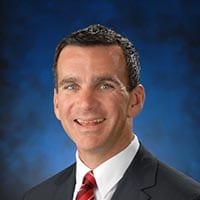Between persistent drug shortages and the seasonal COVID and RSV vaccines, 2023 was packed with medical news of particular interest in primary care. The following four stories were among the most popular with our primary care audience. Here's my take on why these stories resonated with my fellow primary care physicians.
The New Blood Pressure Target in Primary Care
The story. The American Academy of Family Physicians now recommends a target blood pressure of < 140/90 mm Hg in the management of hypertension, which conflicts with the American Heart Association guideline for routine hypertension control with a goal of < 130/80 mm Hg.
Vega's take. The Medscape commentary cites SPRINT, as it should. SPRINT was well conceived and -executed and demonstrated that a target systolic blood pressure of 120 mm Hg was associated with improved mortality outcomes and a composite outcome of cardiovascular events and mortality compared with a goal systolic blood pressure < 140 mm Hg.
In his video, Dr Neil Skolnik mentioned that SPRINT enrolled patients without diabetes but with an elevated risk for cardiovascular events, implying that most patients with hypertension would not qualify for the trial and would probably not benefit from more intensive blood pressure treatment.
But what were those risk factors required for inclusion in SPRINT? An estimated glomerular filtration rate < 60 mL/min/1.73 m2 body surface area was one. A calculated 10-year cardiovascular risk of 15% or more was another. Age at least 75 years? Yes.
Are these criteria common in your practice? They certainly are in mine. So, I usually start the process of setting a blood pressure target for an individual patient with hypertension at 130 mm Hg, and then I see if I need to revise that target upward, based on patient factors, particularly risk for hypotension and its complications. The intensive-treatment group in SPRINT did experience higher rates of hypotension and syncope compared with the standard-treatment cohort.
Bottom line. Work with your patients to set a target blood pressure that makes the most sense for them, but do not hold back intensive antihypertensive treatment from patients who will benefit.
The New Vaccine Your Patients May Not Want
The story. The vaccines for respiratory syncytial virus (RSV), introduced in 2023 for adults age 60 years or older, are effective, with a vaccine efficacy of 94% against severe RSV-related lower respiratory tract disease and 71.7% against any RSV respiratory infection, according to one clinical trial. But patients and healthcare professionals may be suffering from too much vaccine fatigue for the vaccine to launch effectively.
Vega's take. It feels as if I have spent thousands of hours in vaccine counseling/negotiation over the past 4 months. Patients generally do not know what RSV is, and they are disappointed that the influenza vaccine fails to protect against RSV (and SARS-CoV-2 as well). Other headwinds toward complete vaccination this fall for older adults: The Advisory Committee on Immunization Practices created a weaker recommendation for the RSV vaccine, based on shared decision-making; and my clinic does not stock the vaccine. Generally, when my patients agree to get their vaccine at the pharmacy, the completion rate is about 50%.
Bottom line. The Centers for Disease Control and Prevention (CDC) reports that 17.0% of adults at age 60 years or older have received the RSV vaccine as of December 15, 2023. Pretty terrible, but so far it more than doubles the application rate of the 2023/2024 COVID-19 vaccine (7.8%). Arrrrgh. Okay, who wants a drink? I'm buying.
No Expiration Date for Sex
The story. Older adults are more interested in sex and masturbation than many clinicians might think. In a study performed in the United Kingdom in 2015, 59% of men between the ages of 70 and 79 years reported having sex in the past year, and 19% had sex at least twice in the past month. The respective numbers of women at ages 70-79 years were 39% and 6%. Clinicians should be discussing sexual health as part of maintenance of care, without an expiration date.
Vega's take. One of the most accepted prejudices in American society is ageism. My patients have taught me that age does not dictate ambition and achievement, and I agree with Dr Woet Gianotten's examples of patient-centered ways to discuss sexuality among older adults.
Practically speaking, however, I am challenged to find the time to have a discussion regarding sexual health with all of my patients. It is interesting that Dr Gianotten's excellent commentary was just a touch less popular than another valid commentary lamenting the undervalue of lifestyle counseling by clinicians. And if I have limited time to do important but unreimbursed patient counseling for health maintenance, would I prioritize sexual health? Usually, no. Because even when a sexual health issue is problematic, I have few resources to address it effectively.
Bottom line. Don't be ageist. Inquire about sexual health routinely among older adults if you can. But allow yourself a little grace if you cannot.
Physicians May Retire En Masse Soon. What Does That Mean for Medicine?
The story. We are facing a physician shortage that is likely to grow worse. Nearly one quarter of practicing physicians are 65 years of age or older, and burnout has led to younger physicians cutting back on practice time or withdrawing from practice altogether. Patients are feeling the crunch. In 2019, 35% of patients surveyed reported difficulty finding a physician, an increase of 10% since 2015.
Vega's take. A shortfall of physicians is not a new problem. However, the COVID-19 pandemic made this issue (and all issues?) more acute. The good news: Help is on the way! Total enrollment in US allopathic medical schools increased by 31% between 2002 and 2018. Combining this result with increased enrollment at osteopathic medical schools resulted in a 52% increase in students during the same period.
Still, there is a big mismatch between the growth in student enrollment and the number of residency training positions available in the United States. The Resident Physician Shortage Reduction Act was originally introduced in Congress in 2021 and would add 14,000 new resident positions nationally over 7 years. It was reintroduced in 2023, but passage into law is far from guaranteed.
These workforce solutions will take time and still will not fully address the issue of health equity for all. American healthcare will struggle or thrive, based on our ability to create a sustainable model of team-based care that promotes the well-being of patients and providers, practice efficiency, and sensible population-based care.
Bottom line. While there is some reason for hope, healthcare professionals must continue to push for major systemic change to remedy longstanding problems.
Follow Medscape on Facebook, X (formerly known as Twitter), Instagram, and YouTube
Credit:
Lead Image: Medscape illustration / Getty Images
Medscape Family Medicine © 2023 WebMD, LLC
Any views expressed above are the author's own and do not necessarily reflect the views of WebMD or Medscape.
Cite this: Most Popular Stories of 2023: Primary Care Edition - Medscape - Dec 27, 2023.









Comments